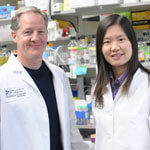Finding could lead to novel drugs that prevent or slow the disease

SAN ANTONIO (Feb. 7, 2011) — Like two unruly boys who need to be split up in class, a pair of protein molecules work together to speed up the toxic events of Alzheimer’s disease. Researchers at the UT Health Science Center San Antonio announced the discovery of the second molecule and said its identification could lead to drugs that disrupt the interaction, and thereby block or slow Alzheimer’s onset or progression.
Alzheimer’s disease is an irreversible, progressive brain disease marked by deterioration of nerve cells and eventual complete loss of cognitive functioning – thinking, memory and reason. Many Alzheimer’s patients have brain lesions called amyloid plaques, which consist of protein fragments called amyloid-beta. Small aggregates of amyloid-beta are thought to contribute prominently to the degeneration of brain cells in Alzheimer’s.
Hope is to disrupt signals
The discovery involves an amyloid beta fragment called AICD. Scientists have known that AICD controls expression of genes that contribute to Alzheimer’s, but how it did so was unclear – until now. “We discovered a protein molecule that communicates with AICD to turn on target genes,” said Thomas G. Boyer, Ph.D., professor of molecular medicine at the Health Science Center. “We hope to exploit this knowledge to identify compounds or drugs that can disrupt these signals, leading to a novel and effective treatment for this disease.”
No treatments of root problem
Alzheimer’s disease is the most common cause of dementia among older people, and estimates indicate that as many as 5.3 million Americans suffer from it. While several drugs approved by the U.S. Food and Drug Administration can temporarily slow worsening symptoms, no treatment is currently available to slow or stop the degeneration of nerve cells that lies at the root of the disease.
The finding is in the Feb. 4 issue of EMBO Reports, published by the European Molecular Biology Organization. The research is the doctoral dissertation of Xu Xuan, a student in Dr. Boyer’s laboratory at the Health Science Center’s Institute of Biotechnology. The other co-author is Haiying Zhou, who obtained her Ph.D. in the Boyer laboratory and is pursuing postdoctoral studies at the University of California, Berkeley.
The University of Texas Health Science Center at San Antonio, one of the country’s leading health sciences universities, ranks in the top 3 percent of all institutions worldwide receiving National Institutes of Health (NIH) funding. Research and other sponsored program activity totaled a record $259 million in fiscal year 2009. The university’s schools of medicine, nursing, dentistry, health professions and graduate biomedical sciences have produced approximately 26,000 graduates. The $744 million operating budget supports eight campuses in San Antonio, Laredo, Harlingen and Edinburg. For more information on the many ways “We make lives better®,” visit www.uthscsa.edu.

